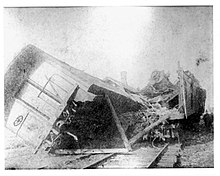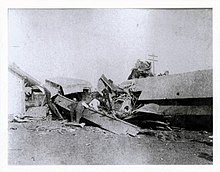Kipton Railway Accident
The Kipton rail accident was the head-on collision of the Toledo Express and the No. 14 mail train on the Lake Shore and Michigan Southern Railroad in Kipton , Ohio on April 18, 1891. Nine people died. As a result of the accident, the time was standardized on the US railways.
Starting position
The station of Kipton was on the single-track route of the Toledo, Norwalk and Cleveland Railroad , whose train protection was secured by Timetable and Train Order , a special form of driving at time intervals . The line was closed in 1975.
The Toledo Express carried five passenger cars and two baggage cars , the mail train carried three staffed rail mail cars and two saloon cars . The vehicles had - it was common at the time - wooden bodies that offered little protection in the event of a collision.
The Toledo Express and the mail train were on the route in opposite directions towards each other. The engine driver could see only relatively late, since freight cars and the reception building of the station itself obstructed the view. Based on the travel times of the trains, the locomotive staff decided where a train crossing should take place. That had to be decided based on the transit time of the first train to pass in Kipton station. The engine driver read the time on his pocket watch .
the accident
Based on the time read on his pocket watch, the driver of the Toledo Express decided that he could continue to the next crossing point. However, what he didn't know, his watch was four minutes behind. As a result, the two trains collided head-on while still in Kipton station.
Two of the rail mail cars splintered completely in the impact, the third fell over and was thrown against the station building. The fragment of one of the colliding locomotives broke through the roof of the neighboring depot . The locomotive of the mail train was on top of that of the passenger train after the accident.
consequences
Nine people died, including six employees of the post office and the engine driver and the stoker on one of the locomotives. The property damage was significant.
As a result, a strict control system was introduced for all clocks used in railway operations: they had to show an accuracy of less than 30 seconds within a week. Each of these watches required a corresponding certificate, which had to be renewed every six months. Traveling inspectors monitored compliance with the rules monthly. The wearers of the watches were obliged to always carry them with them and to store them in such a way that external influences, such as temperature fluctuations, which could influence the running of the watches, were excluded.
The American Railway Authority commissioned the watchmaker Webster Clay Ball as "Chief Time Inspector" to develop reliable control systems and quality standards for clocks used in railway operations. From 1892 onwards, the Hamilton Watch Company produced precisely running "railway workers' watches", the "Ball Railroad Watch".
literature
- Rudolf Wendorff: Time and Culture. History of time consciousness in Europe. 3. Edition. Westdeutscher Verlag, Opladen 1985, p. 427f.
Web links
Individual evidence
- ↑ Pope.
- ↑ Pope.
- ^ North Coast Inland Trail.
- ↑ Pope.
- ↑ Pope.
- ^ North Coast Inland Trail.
- ↑ Pope.
- ↑ Pope.
- ^ North Coast Inland Trail.
- ↑ Pope.
- ↑ Pope.
- ↑ Wendorff, p. 428.
- ↑ Wendorff, p. 428.
- ^ North Coast Inland Trail.
Coordinates: 41 ° 16 ′ 1.4 ″ N , 82 ° 18 ′ 24.2 ″ W.



